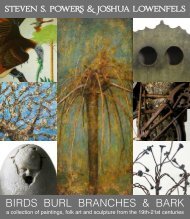WALK THE WALK, TALK THE TALK
“Walk the Walk, Talk the Talk” is more than a clever title for this mix of carved walking sticks, figural ceramics and folk art, but also a philosophy of collecting with courage—of not playing it too safe and embracing outliers. It is finding examples of a genre that push boundaries and surprise us, yet still overlap its predecessors—objects that break preconceived notions and move the line forward. Come see this collection and more at The Philadelphia Antiques & Art Show, April 21-23, 2017.
“Walk the Walk, Talk the Talk” is more than a clever title for this mix of carved walking sticks, figural ceramics and folk art, but also a philosophy of collecting with courage—of not playing it too safe and embracing outliers. It is finding examples of a genre that push boundaries and surprise us, yet still overlap its predecessors—objects that break preconceived notions and move the line forward.
Come see this collection and more at The Philadelphia Antiques & Art Show, April 21-23, 2017.
You also want an ePaper? Increase the reach of your titles
YUMPU automatically turns print PDFs into web optimized ePapers that Google loves.
W A L K T H E W A L K<br />
T A L K T H E T A L K<br />
PHILADELPHIA ANTIQUES & ART SHOW • A P R I L 2 1 - 2 3
S T E V E N S . P O W E R S<br />
W A L K T H E W A L K<br />
T A L K T H E T A L K<br />
“Walk the Walk, Talk the Talk” is more than a clever title<br />
for this mix of carved walking sticks, figural ceramics<br />
and folk art, but also a philosophy of collecting with<br />
courage—of not playing it too safe and embracing<br />
outliers. Finding examples of a genre that push<br />
boundaries and surprise us, yet still overlap its<br />
predecessors—objects that break preconceived<br />
notions and move the line forward.<br />
Come see this collection and more at The Philadelphia Antiques<br />
& Art Show, April 21-23, 2017.<br />
Location: The Navy Yard, Marine Parade Grounds<br />
4747 South Broad Street, Philadelphia, PA 19112<br />
additional show information: philadelphiaantiquesandartshow.com<br />
W O R K S O F<br />
A R T<br />
& a m e r i c a n a<br />
360 Court Street #28, Brooklyn, NY 11231 | 718.625.1715 or 917.518.0809 | stevenspowers.com | member: ADA
Eight is Enough (detail)<br />
Iowa<br />
Concrete and polychrome<br />
Circa: 1920-1930<br />
*full details pages 28-29.
Important Southern Figural Folk Art Stick<br />
North Carolina<br />
Walnut<br />
Circa: 1880<br />
Size: 28" (h)<br />
Provenance: Peter Brams<br />
This is one of the finest figures to appear<br />
on a folk art walking stick extant.<br />
Though the artist is unknown it is<br />
initialed “JE” in script below the male<br />
figure and marked “NC” [North<br />
Carolina] below the rattlesnake.<br />
The surface is untouched and complex<br />
with a rich patina and oxidation.
Rare Redware Monkey Bank & Whistle<br />
Pennsylvania<br />
Circa: 1860<br />
Size: 5" (oah)<br />
Provenance: David Good, Peter Brams
Massive Covered Ash Burl Bowl<br />
Ash burl<br />
Circa: 1780<br />
Size: 14 3/8" (d) x 10" (h)<br />
Provenance: DeVere Card, Avis & Rockwell Gardiner,<br />
Private, Sam Forsythe & David Good, Leigh Keno<br />
Exhibited: Munson-Williams-Proctor Institute, 1971<br />
Pictured and discussed: North American Burl Treen:<br />
Colonial & Native American, page 62-63; and The<br />
Use of Burl in America, page 25.<br />
This is the largest covered ash burl bowl extant.<br />
Covered burl bowls are typically of a vague sugar<br />
bowl size, this enormous example would have likely<br />
been a serving piece brought to the table.<br />
It maintains its original shellac and complex surface.
Southern Stoneware Face Jug<br />
Attributed to E. Galloway<br />
Paducah, KY<br />
Circa: 1880<br />
Size: 9" (oah)<br />
Provenance: Peter Brams<br />
A highly unusual and rare<br />
“Caucasian” face jug sporting<br />
a Van Dyke mustache and<br />
beard. The life-sized face is<br />
made from a stoneware body<br />
and covered with a white<br />
bristol glaze and detailed<br />
with cobalt.
Exceptional English Treen Cheese Scoop<br />
England<br />
Circa: 1760<br />
Size: 6 5/8" (oah)<br />
The ultimate cheese scoop! A great large<br />
folk art face with tight, intricate details<br />
on her sleeves and bodice.<br />
This example is a recent discovery—a<br />
sister scoop, by the same hand and dated<br />
1757, was in The Longridge Collection<br />
of treen.
Folk Art Cane of Man with Bow-tie<br />
New England<br />
Tiger maple / cherry<br />
Circa: 1880<br />
Size: 35"<br />
Provenance: Steve Miller, Peter Brams<br />
Literature: for a cane by the same hand<br />
see, Carved & Whittled Sculpture:<br />
American Folk Art Walking Sticks, Selections<br />
from the Pamela and Tim Hill<br />
Collection, pages 110-111
On The Moors<br />
Peter Coker (1926-2004)<br />
Oil on newspaper<br />
Circa: 1970<br />
Size: 11 3/4" (w) x 11" (h) (sight)<br />
Literature: Catalogue raisonné #183,<br />
illustrated on p. 89.
The Newport Zoo<br />
Newport, KY<br />
Dated: April 6, 1925<br />
Size: 11 1/2" (w) x 5 1/4" (d) x 3 1/2" (h)<br />
A large and unusual piece of Southern<br />
ceramics featuring a menagerie of<br />
animals—an alligator, birds, a fish, and a<br />
turtle.
Nine Hands Cane with Shorebird and Dog<br />
Georgia (attributed)<br />
Circa: 1880<br />
Size: 35" (h)<br />
Provenance: Southern collection<br />
Literature: for a cane by the same hand<br />
see, Carved & Whittled Sculpture:<br />
American Folk Art Walking Sticks,<br />
Selections from the Pamela and Tim Hill<br />
Collection, page 98.<br />
A fascinating and mysterious carving<br />
with nine hands around the stick,<br />
interspersed with carpentry tools and<br />
lizards. The top has a conjoined<br />
shorebird feeding its young and a dog’s<br />
head.<br />
Though the meaning is not known—the<br />
tools and hands make me think of<br />
“helping hands.” Or from a different<br />
perspective, the religious act of “laying<br />
on of hands.”
Important African American<br />
Folk Art Carved Cane<br />
Circa: 1881<br />
Size: 36" (h)<br />
This spirited carving is not<br />
only remarkable for its’<br />
prodigious carvings, it is<br />
the inspired, non-formulaic<br />
execution that makes<br />
it exceptional.<br />
The forty or so carvings<br />
feature; a large capuchin<br />
monkey at the top with a<br />
turtle fetish set into it<br />
(under glass). What<br />
follows is a whole lot of<br />
carving; clusters of shore<br />
birds, 16 or so African<br />
American male heads, a<br />
few snakes, an elephant, a<br />
few dogs, etc.<br />
The male heads all appear<br />
to be African American<br />
which would point to the<br />
race of its carver. The cane<br />
is signed and dated, “BY<br />
TG 1881.”
African American Folk Art head<br />
Circa: 1900<br />
Size: 11 3/8" (oah)
Railroad Station, Randolph<br />
George E. Morgan (1870-1969)<br />
Oil on canvas board<br />
Circa: December 1962<br />
Size: 16" x 20"<br />
Provenance: Anne K. Wardwell; Mr. & Mrs. Sumner and Helen Johnston; Joe<br />
Wetherell; Raymond Saroff and Howard Rose; Peter Brams<br />
Exhibitions: The Playhouse, Boothbay, ME 1963; Farnsworth Art Museum,<br />
Rockland, ME, July 16 - October 11, 1998; The Center for Intuitive and<br />
Outsider Art, Chicago, IL, February 5 - April 10,1999<br />
Literature: “Painter Makes Primitives of Early Boyhood Scenes” KENNEBEC<br />
JOURNAL, February 18, 1966, Ruth Henderson<br />
The Kennebec Central Railroad was a narrow gauge line that ran for five miles<br />
and connected Randolph to the National Veterans Home in Togus, Maine (the<br />
nation’s first veterans home).
Ontario Stoneware Face Jug<br />
Ontario<br />
Circa: 1880<br />
Size: 9" (oah)<br />
Provenance: Ron Korman, Robert<br />
Girourd, Peter Brams<br />
With its dripped manganese glaze, this<br />
rare life-sized face jug is quite wild. The<br />
rich reddish/purple color and wavy<br />
patterning over the hand-built face is<br />
striking.<br />
Handle on back is missing and the ears<br />
are chipped.
Eight is Enough<br />
Iowa<br />
Concrete and polychrome<br />
Circa: 1920-1930<br />
Size: range from 4 1/4" (h) - 7 1/4" (h)<br />
A family of eight concrete dolls.<br />
Found as a group in Iowa, these<br />
“dolls” are unique and mysterious.<br />
Sensational surfaces.
Howard Rackliffe (American, 1917–1987)<br />
Acadian Cliffs<br />
Mixed media on board<br />
Circa: 1968<br />
Size: 21 1/2" (h) x 27 1/2" (w)<br />
Rackliffe’s work is currently the focus of a<br />
centennial retrospective at the New Britain<br />
Museum of American Art.<br />
Rackliffe’s works are represented in the<br />
collections of the Barnes Foundation; New<br />
Britain Museum of American Art; Portland<br />
Museum of Art; and The Farnsworth Museum.
Wild Folk Art Pipe by Richard Wessel, 5th OVI<br />
Harper’s Ferry, West Virginia<br />
Circa: 1865<br />
Size: 9" (w) x 5" (h)<br />
Provenance: Norman Flayderman<br />
An over the top Civil War carved pipe—using<br />
the natural form of the root, Wessel carves a<br />
recumbent lion, panther, lizard and a snake.<br />
Along the body, in relief carved letters, he<br />
states, “This / Root was / Found on / the Banks<br />
of / the Potomac / Near / Harpers Ferry, This<br />
Pipe was / Made By / R. Wessel / A Member / of<br />
/ the 5 OVI / C.A.”<br />
In addition to the animals, Wessel carves and<br />
wax fills an American Flag with the motto, “E.<br />
Pluribus Unum.”
Northern Plains Speaker’s Staff<br />
probably Sioux<br />
Ash with brass tacks<br />
Circa: 1840-1860<br />
Size: 34 1/4" (h)<br />
Beautifully designed with an<br />
overall flat, lizard pattern—the<br />
handle as stylized eagle talons.<br />
Maintaining an exceptional<br />
surface.
Eastern Woodlands Ash Burl Maple Syrup Ladle<br />
Ash burl<br />
Circa: 1800-1820<br />
Size: 40" (oal)<br />
Dark patina exhibiting an extensive use history.
Tattoo You, You and You<br />
San Francisco Bay Area<br />
Reverse painting on glass, paper<br />
Circa: late 1980’s-early 1990’s<br />
Size: 20" (w) x 10 1/2" (h) (sight)<br />
Provenance: Aarne Anton, Peter Brams
Rare Stoneware Monkey Spill Vase<br />
Signed “H. Stell”<br />
York County, Pennsylvania<br />
Circa: 1860-1870<br />
Size: 7" (h) x 6" (w)<br />
Provenance: Robert Girourd, Peter Brams<br />
Henry Stell appears in the 1850 census as<br />
being a potter and living with the Knisely<br />
family.
Maple Burl Civil War Folk Art Carved Pipe,<br />
“The Union and The Constitution Must & Shall<br />
be Preserved”<br />
Circa: 1864<br />
Size: 6" (w) x 3 1/2" (h)<br />
Provenance: Norman Flayderman<br />
A massive pipe with bold, high relief carvings<br />
of crossed cannons and guns with a heart<br />
centered above a star. “The Union and Constitution<br />
Must & Shall be Preserv’d” frames the<br />
upper most part of the pipe, while the owners<br />
initials, “MB” are carved below.
"A Woman's Touch"<br />
Folk Art Carved & Painted Cane<br />
Circa: 1860<br />
Size: 33 1/4" (oal)<br />
The whole in high relief—a large<br />
bird's claw, followed by acorns<br />
wrapped with a rose, which leads to<br />
a woman's forearm and hand, a<br />
rattlesnake wraps a branch and then<br />
another rose, and a turtle near the<br />
end.
The Family Homestead<br />
Folk Art Painted Tintype<br />
Circa: 1870<br />
Size: +/- 7" x 10" (outsized)<br />
Unusual for the amount of people<br />
within one tintype and for being outside<br />
of the studio. The folk art painting over<br />
it, with the symmetrically placed<br />
flowers in the foreground is great.
Circus Cherub<br />
Circa: 1880<br />
Size: 14" (w) x 25" (h)<br />
Provenance: Frederick Fried, Frank Maresca,<br />
Peter Brams<br />
A fragment of a circus wagon figure made<br />
more mysterious and artful through<br />
incidence and age.
Deco Diva<br />
Mahogany<br />
Circa: 1920-1930<br />
Size: 11" (h)<br />
Provenance: Marvill Collection
Yosemite<br />
Signed: “A. Gomer”<br />
Oil on masonite<br />
Circa: 1940-1950<br />
Size: 23 1/2" (w) x 14 1/4" (h)<br />
Provenance: Peter Brams
Rare Ash Burl Reversible Tazza/Bowl<br />
Ash burl<br />
Circa: 1720-1740<br />
Size: 13" (d) x 4" (h)<br />
A recent discovery of an early, undocumented<br />
form. An ingenious two-for-one—a tazza for<br />
serving cheese or pie on one side and when<br />
flipped over a bowl for fruit or nuts.
The Unknown Soldier<br />
Folk Art Painted Tintype<br />
Circa: 1861-1865<br />
Size: +/- 7" x 10" (outsized)<br />
A striking portrait of an Union soldier.
Steven Powers (1968 -)<br />
Broken Branches<br />
Oil on panel<br />
2017<br />
Size: 11" (h) x 14" (w)
Steven Powers (1968 -)<br />
Broken Branches II<br />
Oil on panel<br />
2017<br />
Size: 11" (h) x 14" (w)
S T E V E N S . P O W E R S<br />
W A L K T H E<br />
W A L K<br />
T H E<br />
T A L K<br />
T A L K<br />
PHILADELPHIA ANTIQUES & ART SHOW<br />
A P R I L 2 1 - 2 3 , 2 0 1 7<br />
W O R K S O F<br />
A R T<br />
& a m e r i c a n a<br />
360 Court Street #28, Brooklyn, NY 11231 | 718.625.1715 or 917.518.0809 | stevenspowers.com | member: ADA


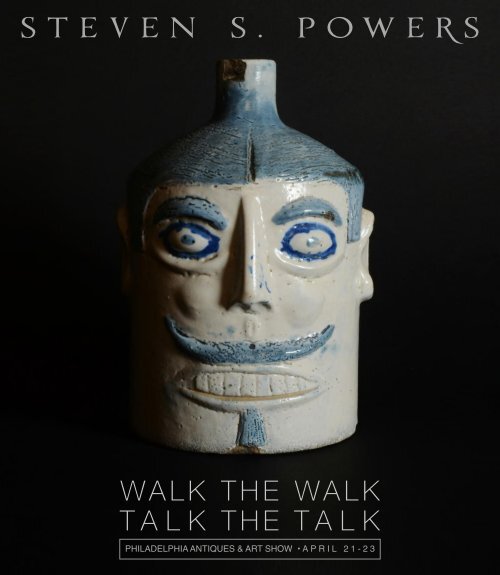

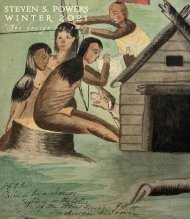
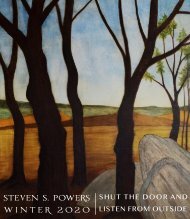
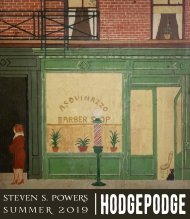
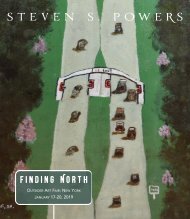

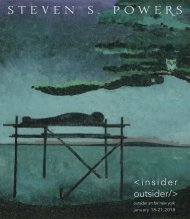
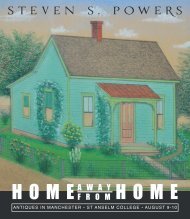
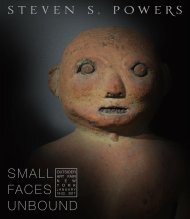
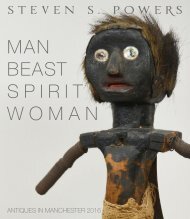
![NEEDLE • KNIFE • TORCH [&] BRUSH](https://img.yumpu.com/55309753/1/190x219/needle-o-knife-o-torch-brush.jpg?quality=85)
